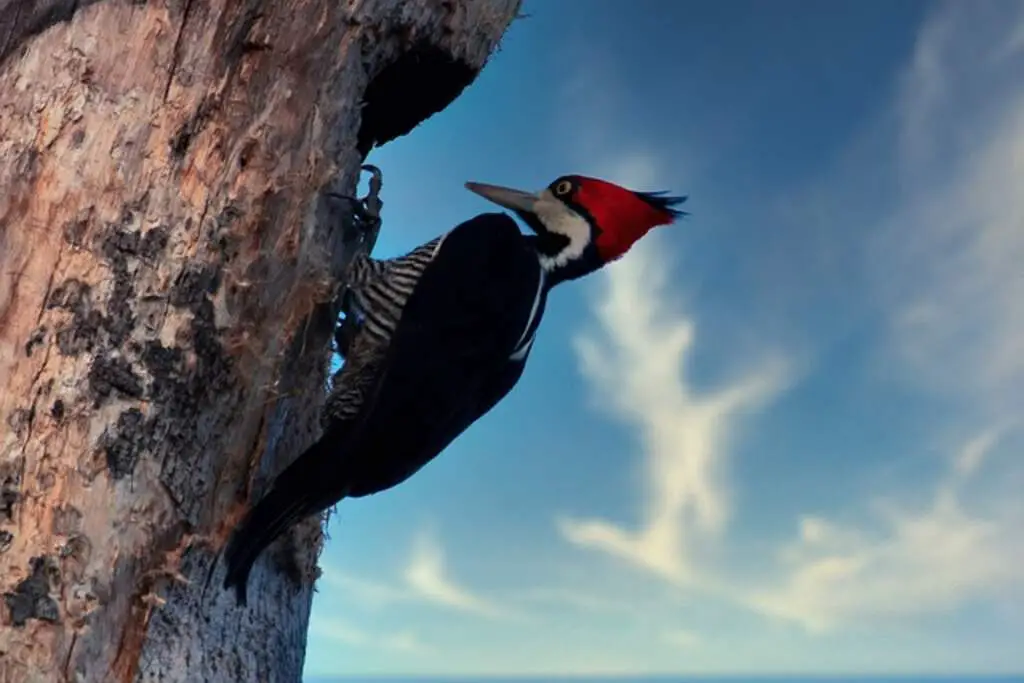Embark on a journey through Maine’s forests with our ultimate guide featuring 7 captivating woodpecker species! From the iconic Pileated Woodpecker to the elusive Black-backed Woodpecker, Maine’s diverse landscapes provide a haven for these fascinating birds.
In this comprehensive guide, we’ll uncover the unique characteristics, habitats, and behaviors of each woodpecker species, offering valuable insights for bird enthusiasts and nature lovers.
Table of Contents
Types of Woodpeckers in Maine
Downy Woodpecker

- Length: 5.5-6.7 in (14-17 cm)
- Weight: 0.7-1.0 oz. (21-28 g)
- Wingspan: 9.8-11.8 in (25-30 cm)
- Scientific Name: Picoides pubescens
- Frequency of Occurrence: 21.16% (Statistic by: eBird)
- Maps: Range Map – Sightings Map
- Sounds: Calls and songs
- Where To Find Them: In Maine, the Downy Woodpecker can be found mostly along the coast from Bangor to Portland and then southward throughout southern areas like Sanford and Cape Elizabeth. They are also present in forested areas near lakes and rivers, such as Sebago Lake State Park and Allagash Wilderness Waterway. In more rural locations, such as Aroostook County, these birds can be seen more frequently than in built up urban centers like Portland.
- How to Attract: When selecting a feeder for Downy Woodpeckers, you should select one that offers suet as part of its food source. Suet offers plenty of energy in the form of fat which is beneficial to this species of bird during the colder winter months when other food sources may be scarce. Additionally, providing sunflower seeds and nuts will also draw Downy Woodpeckers to your yard, as they love eating these types of foods.
Description: The Downy Woodpecker (Dryobates pubescens) is a common North American bird species that can be found in woodlands, parks and gardens. These small-sized woodpeckers are characterized by their characteristic black and white bodies, with a black head with a red patch at the back of the neck for males. They have rounded wings and short legs, allowing them to cling onto trees or other vertical surfaces when searching for food or excavating cavities.
Downy Woodpeckers inhabit most of North America from Alaska down to Florida, as well as parts of Central America. In summer months, they are also found further north into Canada’s boreal forests. Their habitat consists of a variety of deciduous and coniferous woodland types including old growth forest as well as parks and suburban areas.
Related: How to Attract Downy Woodpeckers to Your Yard? (Easy!)
Hairy Woodpecker
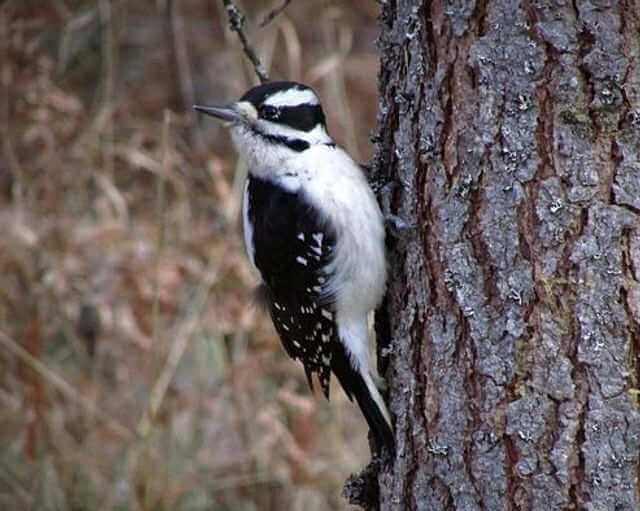
- Length: 7.1-10.2 in (18-26 cm)
- Weight: 1.4-3.4 oz. (40-95 g)
- Wingspan: 13.0-16.1 in (33-41 cm)
- Scientific Name: Picoides villosus
- Frequency of Occurrence: 16.21%
- Maps: Range Map – Sightings Map
- Sounds: Calls and songs
- Where To Find Them: In general, they are most common in areas with mature forests and plenty of dead trees to use for nesting and foraging. They are also known to inhabit urban settings, where they will take advantage of easily accessible food sources such as suet feeders and other bird feeders. The coastal regions of Maine provide an ideal habitat for this species; however, they can be found in all types of habitats across the state including woodland edges, open forests and farmland.
- How To Attract: The first step to attracting a Hairy Woodpecker is setting up the right type of feeders. A suet or peanut butter feeder with a perch area is ideal, as these birds prefer thick sources of food such as sunflower seeds, nuts and suet over traditional seed mixes. If possible, set up multiple types of feeders so that you can provide them with different types of food sources throughout the day.
Description: The Hairy Woodpecker (Picoides villosus) is a medium-sized woodpecker native to North America. It is widely distributed throughout the continent, ranging from southern Canada all the way down to northern Mexico. The bird has also been introduced to Hawaii and parts of Europe.The Hairy Woodpecker prefers habitats that contain mature deciduous or coniferous trees, but it can often be found near open fields as well.
This species tends to avoid urban areas but will use man-made structures such as utility poles for nesting and roosting sites. Its diet consists primarily of insects taken from bark and sap wells, though it will sometimes consume wild fruits too. Insects eaten by this species include ants, beetles, caterpillars and many others; however, it will occasionally feed on berries and nuts when available.
Pileated Woodpecker
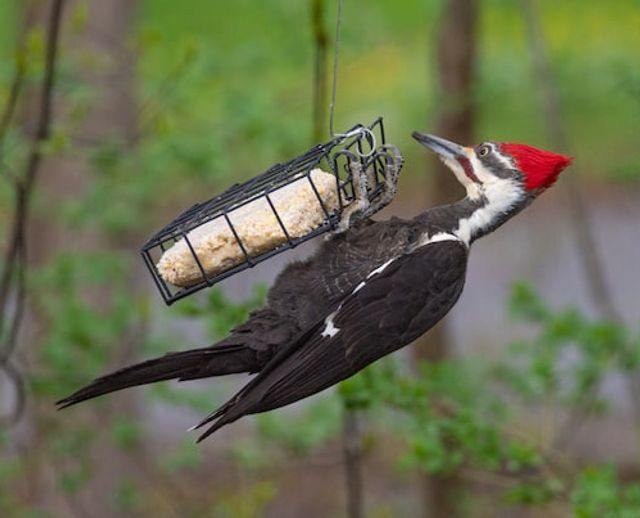
- Length: 15.8-19.3 in (40-49 cm)
- Weight: 8.8-12.3 oz. (250-350 g)
- Wingspan: 26.0-29.5 in (66-75 cm)
- Scientific Name: Dryocopus pileatus
- Frequency of Occurrence: 6.50%
- Maps: Range Map – Sightings Map
- Sounds: Calls and songs
- Where To Find Them: In particular, the Pileated Woodpecker can be seen around Aroostook County near Houlton as well as near Moosehorn National Wildlife Refuge in Washington County. Other notable sightings include Baxter State Park, Rangeley Lake State Park, Cobscook Bay State Park and Acadia National Park on Mount Desert Island. In addition to these locations, various other parts of Maine’s landscape provide suitable habitat for this wonderful bird species.
- How To Attract: Attracting Pileated Woodpeckers to your yard is an exciting way to observe these unique birds up close and personal. In order to draw them in, there are certain types of feeders you can use as well as specific food sources that will entice them. Suet feeders are great for attracting these woodpeckers, since they prefer insects or suet over seeds or nuts. You can place suet feeders near tree trunks at least five feet off the ground so that the birds feel safe enough to land and eat without fear of predators.
Description: The Pileated Woodpecker (Dryocopus pileatus) is a fascinating bird species that is unique to North America. This large, black-and-white woodpecker can be found in both deciduous and coniferous forests throughout nearly all the continent. It has an impressive wingspan between 32 and 40 inches, and its distinctive call can be heard from up to a mile away.
Pileated Woodpeckers are mostly ground-dwelling birds, although they will sometimes build nests high up in trees or even telephone poles. They prefer to inhabit mature woodlands with plenty of dead or decaying hardwood trees and fallen logs on the forest floor. These provide them with an abundance of insects, their preferred food source, as well as some fruits and nuts during the winter months.
Related: How to Attract Pileated Woodpeckers to your Yard (Fast)
Red-bellied Woodpecker
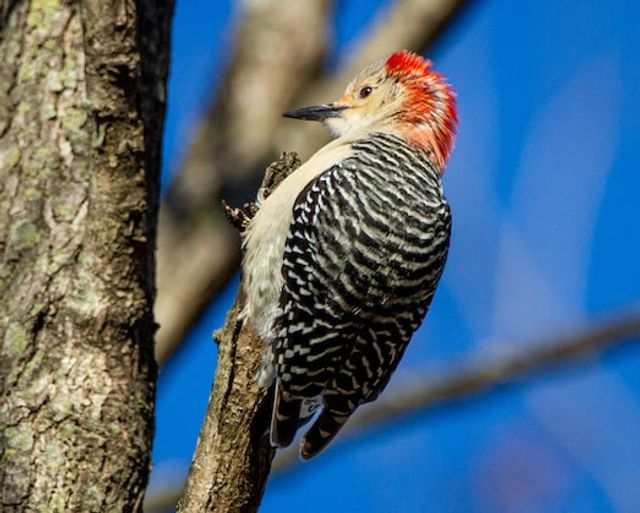
- Length: 9.5 in (24 cm)
- Weight: 2.0-3.2 oz. (56-90 g)
- Wingspan: 13.0-16.5 in (33-42 cm)
- Scientific Name: Melanerpes carolinus
- Frequency of Occurrence: 5.68%
- Maps: Range Map – Sightings Map
- Sounds: Calls and songs
- Where To Find Them: The Red-bellied Woodpeckers in Maine inhabit deciduous forests near ponds and wetlands, often at higher elevations than other woodpecker species in the area. The most common areas to find these birds are along coastal regions including Mount Desert Island, Acadia National Park, Gulf Hagas Wilderness Area, and Baxter State Park.
- How to Attract: To attract them to your yard, you need to provide the right type of feeders and food sources. Platform or hopper feeders are ideal for offering nuts, sunflower seeds, or suet mix that red-bellied woodpeckers love. You can also hang a mesh bag filled with large chunks of peanuts or peanut butter mixed with cornmeal from a tree branch to make it easier for them to access. Offering fresh fruit such as apples and bananas can also be beneficial.
Description: The Red-Bellied Woodpecker (Melanerpes carolinus) is a species of woodpecker found throughout much of the eastern United States, with some isolated populations in southwestern Canada. This bird lives in both deciduous and coniferous forests, but tends to favor hardwood habitats.
These birds have also been recorded inhabiting orchards, farms, and other open areas near forests. Red-bellied Woodpeckers feed mainly on insects such as grubs and beetles, but they also enjoy nuts such as oak acorns and beechnuts when available. They will also eat fruit, including wild grapes and blueberries, as well as suet from bird feeders put out by people.
Related: How to Attract Red-bellied Woodpeckers to your Yard?
Black-backed Woodpecker

- Length: 9.1 in (23 cm)
- Weight: 2.1-3.1 oz. (61-88 g)
- Wingspan: 15.8-16.5 in (40-42 cm)
- Scientific Name: Picoides arcticus
- Frequency of Occurrence: 0.1341%
- Maps: Range Map – Sightings Map
- Sounds: Calls and songs
- Where To Find Them: Black-backed Woodpecker are found primarily in forests with dead trees, particularly those affected by outbreaks of forest pests such as bark beetles or spruce budworm. These areas provide an abundant source of food for the birds, including beetle larvae and other invertebrates which they excavate from decayed wood. They are most commonly seen in northern Maine, where a number of large stands of dead trees have formed due to these insect infestations.
- How to Attract: The first step towards attracting these woodpeckers is by providing them with suitable food sources. Suet feeders filled with nuts, seeds, and suet cakes are an excellent choice for this species. Adding some peanut butter or fruit preserves will also add variety and appeal to the feeders. Insects such as crickets or mealworms should also be offered on trays covered with a mesh screen. Additionally, placing some large logs near feeders may entice them even more as they search for insects underneath the bark while looking for food.
Description: The Black-backed Woodpecker is a medium-sized woodpecker that can be found on the western side of North America. It ranges from Alaska and British Columbia in the north, to as far south as California, Arizona and New Mexico. This species mainly inhabits coniferous forests such as those found in boreal regions, but they will also use deciduous areas.
They prefer living in an area where there are plenty of dead trees for them to make their nests and forage for food. The diet of the Black-backed Woodpecker consists mainly of insects such as wood boring beetles, ants and centipedes that are hidden beneath bark or deep within crevices of decaying logs. They will also feed on seeds when available.
Red-headed Woodpecker
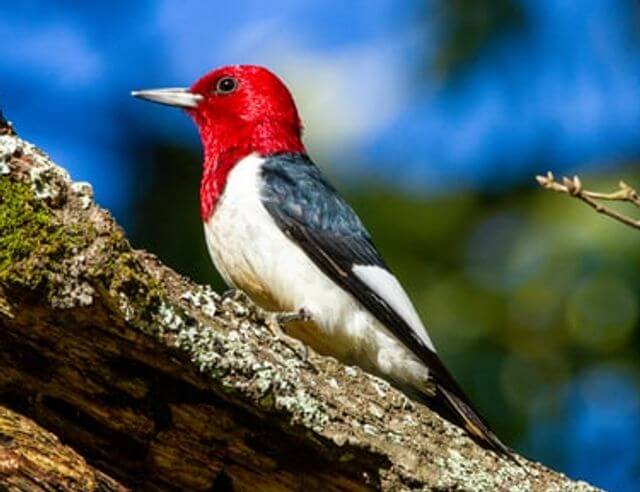
- Length: 7.5-9.1 in (19-23 cm)
- Weight: 2.0-3.2 oz. (56-91 g)
- Wingspan: 16.5 in (42 cm)
- Scientific Name: Melanerpes erythrocephalus
- Frequency of Occurrence: 0.0543%
- Maps: Range Map – Sightings Map
- Sounds: Calls and songs
- Where To Find Them: Maine’s coastal regions are home to a small population of Red-headed Woodpeckers during the breeding season due to its abundance of mature trees. They can also be found across much of western Maine, especially near rivers or streams surrounded by deciduous forests.
- How to Attract: Suet feeders are great food sources for these birds as they love suet, peanut butter mixtures, nuts, and sunflower seeds. Additionally, it’s important to hang the feeder in an open area with plenty of space, so they can easily access their food without being disturbed by predators or other animals.
Description: The Red-headed Woodpecker is a colorful and unique species of woodpecker that can be found in the United States, Mexico, and Canada. This bold bird is identified by its bright red head and white body, with black wings and tail. It has long been a favorite among birders due to its remarkable beauty and rarity.
The range of the Red-headed Woodpecker includes parts of central and eastern North America, stretching from southern Canada to northern Mexico. The species generally prefers open woodlands such as savannas or parkland, but they have also been known to inhabit residential areas as well as dead trees in forests. They are sometimes seen along riversides or on power lines in their search for food.
Related: Interesting Red-Headed Woodpecker Facts (Explained)
American Three-toed Woodpecker
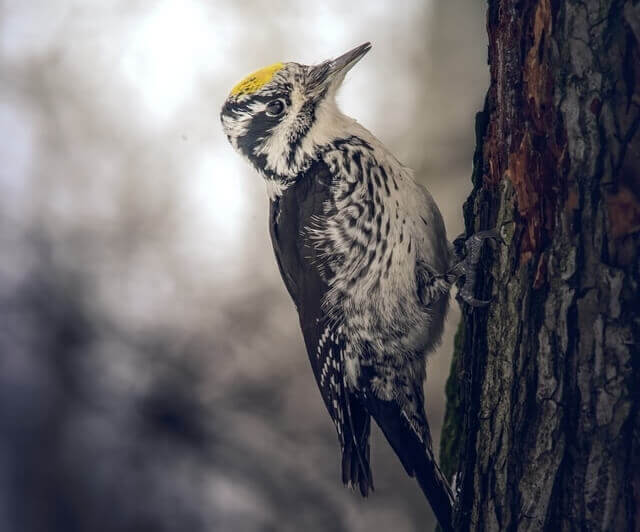
- Length: 8.3-9.1 in (21-23 cm)
- Weight: 1.6-2.4 oz. (44.8-67.9 g)
- Wingspan: 14.6-15.3 in (37-39 cm)
- Scientific Name: Picoides dorsalis
- Frequency of Occurrence: 0.0142%
- Maps: Range Map – Sightings Map
- Sounds: Calls and songs
- Where To Find Them: In Maine, these birds are very rare, but can be seen in the northern forest region, where they nest and feed on insects hidden beneath bark or by excavating holes for sap and eggs. They have also been spotted near mountain summits and along rivers throughout the state. Additionally, they can often be observed along the coastlines of Maine’s islands including Monhegan Island as well as parts of Acadia National Park.
- How to Attract: American Three-toed Woodpeckers are incredibly interesting birds to observe and can be a great addition to your backyard birding experience. Fortunately, there are several steps you can take to make your yard more attractive for these woodpeckers. First, choose the type of feeder that is most likely to bring them in – suet feeders or platform feeders with nuts and seeds seem to be particularly attractive to American Three-toed Woodpeckers. Second, provide sources of food such as insects or berries that they would naturally find in the wild. Finally, add natural elements like trees and dead logs where they can forage for food or just hang out.
Description: The American Three-toed Woodpecker (Picoides dorsalis) is a medium-sized woodpecker found across much of central, eastern and northern North America. These birds inhabit coniferous forests, particularly those with mature or old growth trees. They are a large part of the boreal forest ecosystem and an important indicator species of its health.
American Three-toed Woodpeckers feed on insects, especially bark beetles, that live beneath the bark of trees. They also eat larvae, spiders and other arthropods found in dead tree trunks, as well as fruit such as cherries and service berries. During winter months, they may also feed on suet offerings from backyard bird feeders.

